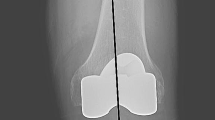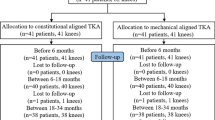Abstract
Background
Navigated total knee replacements (TKR) have shown better knee function and quality of life. It also reduces revision rates. The aim of our study is to evaluate short to mid-term clinico-radiological and functional results, survival rate and complications of Gradius knee prosthesis implanted using computer navigation.
Methods
We retrospectively reviewed 120 Gradius knee prosthesis, implanted in 68 patients (52 bilateral TKR and 16 unilateral TKR) and followed from Jan 2015 till Jan 2020. Pre-operative & post-operative radiographs, knee society scores (KSS), range of motion (ROM), deformity assessment and gait video recordings were done for all patients.
Results
The mean follow-up was 3.8 years (minimum 2–5 years).The mean ROM was 2° (0–10) extension to 135° (128°–138°) flexion. The KSS pain score improved from mean of 38.3 (range 26–44) to 90.4 (mean 88–92). The KSS functional score improved from 36.2 (range 28–39) to 92.6 (range 86–94). All patients had excellent to good function during successive follow-ups. The coronal alignment improved from 8° varus to 0.3° varus. Sagittal alignment was corrected from 8° (4°–18°) preoperatively to 2° (0°–8°) postoperatively
Conclusion
At mid-term our series outlines the better functional and radiological results of Gradius knee prosthesis using navigation as a tool. We recommend a prospective randomized controlled trials comparing navigated versus non-navigated for Gradius knee prosthesis with long-term follow-up.



Similar content being viewed by others
References
Picard, F., Deep, K., & Jenny, J. Y. (2016). Current state of the art in total knee arthroplasty computer navigation. Knee Surgery, Sports Traumatology, Arthroscopy, 24(11), 3565–3574.
Suero, E. M., Lueke, U., Stuebig, T., Hawi, N., Krettek, C., & Liodakis, E. (2018). Computer navigation for total knee arthroplasty achieves better postoperative alignment compared to conventional and patient-specific instrumentation in a low-volume setting. Orthopaedics & Traumatology: Surgery & Research, 104(7), 971–975.
Choong, P. F., Dowsey, M. M., & Stoney, J. D. (2009). Does accurate anatomical alignment result in better function and quality of life? Comparing conventional and computer-assisted total knee arthroplasty. The Journal of Arthroplasty, 24(4), 560–569.
De Steiger, R. N., Liu, Y. L., & Graves, S. E. (2015). Computer navigation for total knee arthroplasty reduces revision rate for patients less than sixty-five years of age. JBJS, 97(8), 635–642.
Lacko, M., Schreierová, D., Čellár, R., & Vaško, G. (2018). Long-Term Results of Computer-Navigated Total Knee Arthroplasties Performed by Low-Volume and Less Experienced Surgeon. Acta chirurgiae orthopaedicae et traumatologiae Cechoslovaca., 85(3), 219–225.
Kamat, Y. D., Aurakzai, K. M., & Adhikari, A. R. (2014). Total knee replacement in the obese patient: comparing computer assisted and conventional technique. The Scientific World Journal, 2014, 272838. https://doi.org/10.1155/2014/272838.
Weng, Y. J., Hsu, R. W. W., & Hsu, W. H. (2009). Comparison of computer-assisted navigation and conventional instrumentation for bilateral total knee arthroplasty. The Journal of Arthroplasty, 24(5), 668–673.
Yu, Q. B., Xin, H. W., Zhang, Y. S., & Lin, Y. Z. (2020). Effect of total knee arthroplasty under computer navigation on intraoperative blood loss and joint function recovery. Zhongguo gu Shang China Journal of Orthopaedics and Traumatology, 33(1), 15–20.
Panjwani, T. R., Mullaji, A., Doshi, K., & Thakur, H. (2019). Comparison of functional outcomes of computer-assisted vs conventional total knee arthroplasty: a systematic review and meta-analysis of high-quality, prospective studies. The Journal of Arthroplasty, 34(3), 586–593.
Cip, J., Widemschek, M., Luegmair, M., Sheinkop, M. B., Benesch, T., & Martin, A. (2014). Conventional versus computer-assisted technique for total knee arthroplasty: a minimum of 5-year follow-up of 200 patients in a prospective randomized comparative trial. The Journal of Arthroplasty, 29(9), 1795–1802.
Lützner, J., Dexel, J., & Kirschner, S. (2013). No difference between computer-assisted and conventional total knee arthroplasty: five-year results of a prospective randomised study. Knee Surgery, Sports Traumatology, Arthroscopy, 21(10), 2241–2247.
Baumbach, J. A., Willburger, R., Haaker, R., Dittrich, M., & Kohler, S. (2016). 10-year survival of navigated versus conventional TKAs: A retrospective study. Orthopedics, 39(3), S72–76.
Webb, J. E., Yang, H. Y., Collins, J. E., Losina, E., Thornhill, T. S., & Katz, J. N. (2017). The evolution of implant design decreases the incidence of lateral release in primary total knee arthroplasty. The Journal of Arthroplasty, 32(5), 1505–1509.
Martin, J. R., Jennings, J. M., Watters, T. S., Levy, D. L., McNabb, D. C., & Dennis, D. A. (2017). Femoral implant design modification decreases the incidence of patellar crepitus in total knee arthroplasty. The Journal of Arthroplasty, 32(4), 1310–1313.
White, P. B., Sharma, M., Siddiqi, A., Satalich, J. R., Ranawat, A. S., & Ranawat, C. S. (2019). Role of anatomical patella replacement on anterior knee pain. The Journal of Arthroplasty, 34(5), 887–892.
Ranawat, C. S., White, P. B., West, S., & Ranawat, A. S. (2017). Clinical and radiographic results of attune and PFC sigma knee designs at 2-year follow-up: A prospective matched-pair analysis. The Journal of Arthroplasty, 32(2), 431–436.
Kim, Y. H., Park, J. W., & Kim, J. S. (2018). Chitranjan S. Ranawat Award: Does computer navigation in knee arthroplasty improve functional outcomes in young patients? A randomized study. Clinical Orthopaedics and Related Research, 476(1), 6.
Kim, Y. H., Park, J. W., & Kim, J. S. (2017). The clinical outcome of computer-navigated compared with conventional knee arthroplasty in the same patients: a prospective, randomized, double-blind, long-term study. JBJS, 99(12), 989–996.
Staats, K., Wannmacher, T., Weihs, V., Koller, U., Kubista, B., & Windhager, R. (2019). Modern cemented total knee arthroplasty design shows a higher incidence of radiolucent lines compared to its predecessor. Knee Surgery, Sports Traumatology, Arthroscopy, 27(4), 1148–1155.
Bonutti, P. M., Khlopas, A., Chughtai, M., Cole, C., Gwam, C. U., Harwin, S. F., et al. (2017). Unusually high rate of early failure of tibial component in ATTUNE total knee arthroplasty system at implant-cement interface. THE journal of Knee Surgery., 30(05), 435–439.
Jorgensen, N. B., McAuliffe, M., Orschulok, T., Lorimer, M. F., & De Steiger, R. (2019). Major aseptic revision following total knee replacement: a study of 478,081 total knee replacements from the Australian Orthopaedic Association National Joint Replacement Registry. JBJS, 101(4), 302–310.
Ollivier, M., Parratte, S., Lino, L., Flecher, X., Pesenti, S., & Argenson, J. N. (2018). No benefit of computer-assisted TKA: 10-year results of a prospective randomized study. Clinical Orthopaedics and Related Research, 476(1), 126.
Rhee, S. J., Kim, H. J., Lee, C. R., Kim, C. W., Gwak, H. C., & Kim, J. H. (2019). A comparison of long-term outcomes of computer-navigated and conventional total knee arthroplasty: A meta-analysis of randomized controlled trials. JBJS, 101(20), 1875–1885.
Harvie P, Sloan K, Beaver RJ (2012) Computer navigation vs conventional total knee arthroplasty: five-year functional results of a prospective randomized trial. The Journal of arthroplasty. 1;27(5): p. 667–72.
Hernández-Vaquero, D., Suarez-Vazquez, A., & Iglesias-Fernandez, S. (2011). Can computer assistance improve the clinical and functional scores in total knee arthroplasty? Clinical Orthopaedics and Related Research., 469(12), 3436–3442.
Kim, Y.-H., Park, J.-W., & Kim, J.-S. (2012). Computer-navigated versus conventional total knee arthroplasty: a prospective randomized trial. Journal of Bone and Joint Surgery. American Volume, 94, 2017–2024.
Funding
There is no funding source.
Author information
Authors and Affiliations
Contributions
All authors contributed to the study conception and design. Material preparation, data collection and analysis were performed by all the authors. The final draft of the manuscript was written by senior author (MS) and all authors commented on previous versions of the manuscript. All authors read and approved the final manuscript.
Corresponding author
Ethics declarations
Conflict of Interest
All authors declare that they have no conflict of interest.
Ethical Approval
The study was approved by ethical review committee of our hospital.
Informed Consent
Written informed consent was taken from all the patients included in the study before writing this article.
Additional information
Publisher's Note
Springer Nature remains neutral with regard to jurisdictional claims in published maps and institutional affiliations.
Rights and permissions
About this article
Cite this article
Sharma, M., Dhanjani, B., Bashir, J. et al. Clinico-Radiological and Functional Results of the Navigated Gradius (Gradually Reducing Radius) Knee Prosthesis at Short to Mid-Term Follow-Up. JOIO 55 (Suppl 1), 62–68 (2021). https://doi.org/10.1007/s43465-020-00266-5
Received:
Accepted:
Published:
Issue Date:
DOI: https://doi.org/10.1007/s43465-020-00266-5




